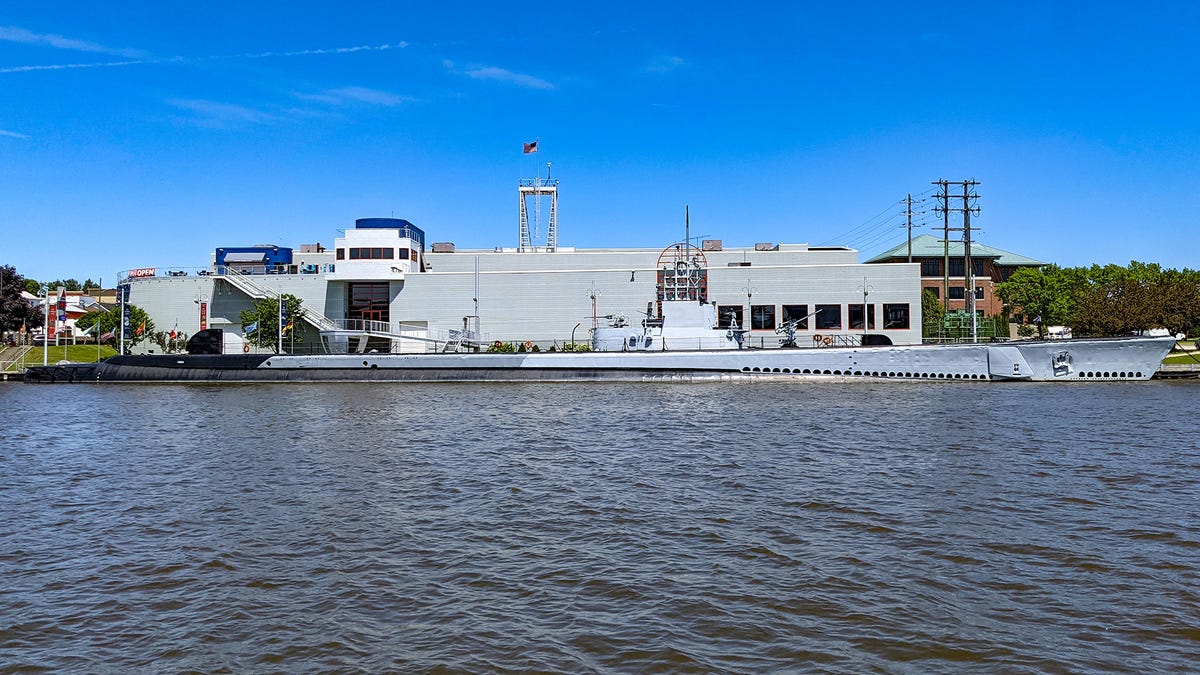Touring the WWII-era USS Cobia submarine
The historic submarine is the centerpiece of the Wisconsin Maritime Museum.

The Wisconsin Maritime Museum and the USS Cobia are in Manitowoc on Lake Michigan.
For more details about the museum, and the submarine, check out my tour of the USS Cobia and the Wisconsin Maritime Museum.
A lake might seem like strange place for a submarine and maritime museum, but the area has a long history of shipbuilding.
The Manitowoc Shipbuilding Company built 28 Balao- and Gato-class submarines. They were launched sideways into the Manitowoc river.
The USS Cobia was launched in 1943. Though she's on display in Manitowoc, she was built in Groton, Connecticut.
The Cobia is a Gato-class sub, which served throughout WWII. Though gato means "cat" in Spanish, the USS Gato and others like her were named after a fish. Specifically, a type of catshark.
This huge machine was one of three triple-expansion steam engines that propelled the SS Chief Wawatam, a ferry and icebreaker that crossed the Straits of Mackinac between Michigan's Upper and Lower peninsulas for most of the 20th century.
The Cobia went on six war patrols in the Pacific, where she sank 13 Japanese vessels, including two that were headed for the island of Iwo Jima shortly before the US invasion in 1945.
The Cobia is just over 311-feet long. The typical crew compliment was 70 enlisted and 10 officers.
In addition to torpedoes, she had three deck guns. This one is a Bofors 40 mm.
An Oerlikon 20mm cannon, was typically for anti-aircraft use.
The main surface weapon on the Cobia at launch was a 3-inch, 50-caliber gun, though many Gato-class subs had 4- and 5-inch guns retrofitted.
Like most submarine museum ships, you enter through a hole cut in the hull with easy-to-use stairs. In service, the only way on or off were through ladders and hatches.
In the bow of the sub is the forward torpedo room. The Cobia had six forward-facing torpedo tubes, and four aft.
Torpedoes were expensive and limited. The Cobia could only carry 24 at a time.
As space is limited on all submarines, the torpedo room shares space with 13 berths.
The Cobia's officers and crew ate well.
The wardroom is where officers took their meals (actual meals not pictured).
The officers got better accommodation than the rest of the crew, but most still had to share a cabin.
The Gato-class was a big submarines, for its day, and included such luxuries as... an office. It also had ample fresh water, showers, clothes washers and more.
At the center of the boat is the control room.
Note the red bar, unlit now, that shows the position of the rudder.
Because of their size, Gato-class ships were initially slow to dive. After some modifications and extensive crew training, they ended up being one of the faster diving subs in the war.
Plotting the correct course is crucial when you can't exactly stop and ask for directions.
You can peek up into the conning tower.
A benefit of her size was extended range, roughly 11,000 nautical miles. This was crucial for extended patrols in the Pacific.
Like other Gato-class subs, the Cobia was rated to a depth of 300 feet. For comparison, a recreational scuba diver usually wouldn't go deeper than 60 feet without special equipment or training.
A group of volunteers helps keep much of the radio room's electronics working.
It's a nice touch to show the galley with food in it. On most museum ships it's empty.
The crew's mess is where they'd eat and relax when not on duty.
The main crew compartment held 36 berths.
Rare for a sub of this era, the Cobia had air conditioning. While this was great for the crew's comfort, it's bigger purpose was dehumidifying the sub's interior. That helped prolong the life and reduce the maintenance of the boat's mechanical and electronic components.
The Cobia had four, two-stroke V16 diesel engines built by GM.
Like nearly all non-nuclear submarines, these big diesels didn't directly drive the sub. Instead, they were connected to generators, which charged batteries that supplied power to four electric motors. Those in turn propelled the sub.
Each engine room had extensive dials and readouts so engineers could carefully monitor engine and motor performance.
These huge levers could direct power to the batteries, disengage generators, reverse the motors, and so on.
With two screws, the Cobia was capable of 21 knots on the surface (approximately 24mph), and 9 knots submerged.
Four more torpedo tubes faced aft. Some Gato-class subs were retrofitted with an electronics suite for fleet radar support instead of a rear torpedo room.
For more information about this sub, and the rest of the Wisconsin Maritime Museum, read my account of exploring the USS Cobia and the Wisconsin Maritime Museum.

